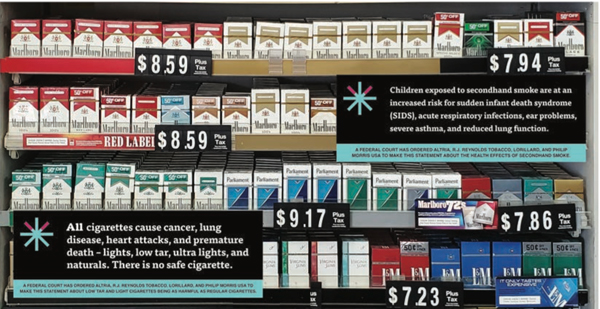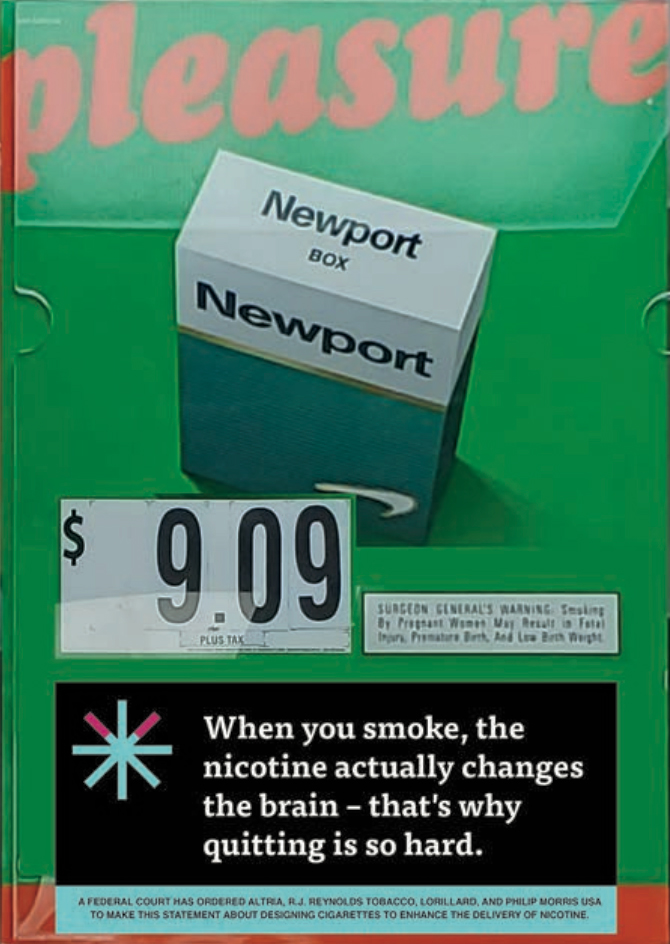According to the DOJ proposal, the size of the message signs varies depending on the total area of the set display. In the proposal, the DOJ lists message sign sizes from 1.75” high by 4” wide up to 20.25” high by 33.5” wide. Depending on the size of the message sign, the signs will partially or fully cover one or more rows of cigarette packages on the cigarette display along with one or more price channels usually located directly beneath the cigarette packages. Below is a DOJ mockup of a set display showing two different message signs covering 25 percent of the Philip Morris USA display area.

In addition, manufacturers would also be required to display the corrective statement messages on “off-set point-of-sale material” in all retail stores which sell, advertise, or promote the manufacturers’ cigarette brands if the manufacturers pay a retailer for displaying point-of-sale material. The DOJ defines “off-set point-of-sale material” as marketing, advertising, and promotional material for one or more covered cigarette brands at a store, other than material in or on a set display. Such material is often displayed on, or suspended from, ceilings, counters, doors, walls, gas pumps, light poles, utility poles, and other locations in or on the store premises. Below is a DOJ mock-up of two off-set point-of-sale materials with each showing a corrective message covering 25 percent of the total material area.
 Upcoming Evidentiary Hearing: An evidentiary hearing on the DOJ proposal is required
Upcoming Evidentiary Hearing: An evidentiary hearing on the DOJ proposal is required
because during the course of this litigation the U.S. Court of Appeals for the District of Columbia Circuit ruled that the District Court must either abandon the point-of-sale remedy in its entirety or modify the plan to protect the rights of innocent retailers. Since retailers were never a party to the DOJ lawsuit against the major cigarette manufacturers, retailers have constitutional rights that protect them from being required to communicate government-mandated messages.
Over the past four months since the DOJ issued its proposal for the display of the corrective statement messages in retail stores and leading up to the evidentiary hearing in July, a number of legal procedures have been and will be undertaken. These procedures include taking the depositions of DOJ expert witnesses, compiling witness declarations (similar to an affidavit) from retailers to detail the impact that the proposed point-of-sale remedy would have on their stores, having manufacturer expert witnesses draft reports on the impact of the corrective statement messaging remedy, allowing the DOJ to take depositions of manufacturer and/or retailer witnesses, and then attending and conducting a hearing before the U.S. Federal District Court judge to present evidence on the DOJ proposal.
NATO has been and will be involved in this litigation as a non-party including preparing four
NATO retail member witnesses for possibly testifying during the evidentiary hearing in July. As this legal process continues, NATO will issue update reports to the NATO membership.
Note: The proposed DOJ point-of-sale messages are separate and different from the U.S. Food and Drug Administration’s new graphic cigarette health warnings which are to be printed on cigarette packages, cigarette cartons, and in cigarette advertisements.







